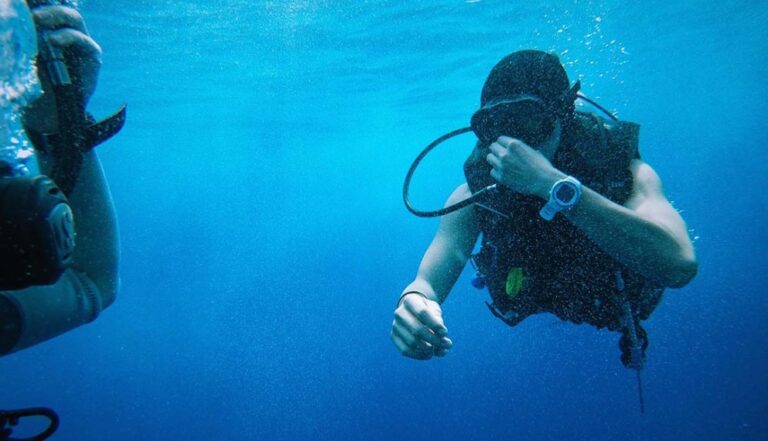Every scuba diver knows that they need to do a safety stop every dive. That might sound like an obvious statement, but there are still many divers who don’t follow the rule. If you’re not sure why it’s important, then read on for our list of reasons and tips for doing your safety stop correctly!
Table of Contents
What is a safety stop and why do I need one every dive?
A safety stop is a mandatory pause before you ascend from the water. It’s important to do this every dive, because it gives bubbles time to form on your body and prevents decompression sickness (or “the bends”). If you’re not sure why, read our article for all of those details!
One thing that many divers don’t realize about their safety stop is they need to make it at least 15-20 seconds long. The longer the better! You can use any type of air device or buoyancy control device during these stops – just have them ready when you get close enough to the surface so there aren’t any delays in stopping. Read more tips below about what else should be done during a safety stop!
What is decompression sickness
We know that when we dive, we do not have access to free air. We need to depend on the air that is compressed and comes out of tanks.When we dive underwater, nitrogen builds up in our blood. Our body gets it from the air. As long as we stay underwater, the nitrogen will slowly get absorbed into our tissues. When we start to come back to the surface, nitrogen starts leaving our tissues as a result of decreasing pressure on our tissues. Do not go up too fast. If you do, the pressure will be different. This can cause bubbles in your blood and other parts of your body. When there are bubbles in our body, that can make you have decompression sickness.
How to perform a safety stop
Safety stops are easy, so do one every time you dive. You simply have to stop on the way up to the surface and stay at around 5 meters/15 feet for 3 minutes. Once you find it hard to maintain the same depth, use an anchor or rope to hold on. If you don’t have a line, it is easier to stay at 6m / 19ft as oppose to 4-5 m/ 15 ft.
The pressure changes at a deep depth can be intense and put you at risk of decompression sickness if you don’t follow the appropriate steps.
Many people who just start practicing diving will not know what is required by them to perform safety stop, this text gives detailed explanation for what it is and why we need to do one every dive.
Though you are at a safe depth, make sure to have your dive computer or free diving watch alert you if you start ascending.
Benefits of performing a safety stop on every dive
Although in short dives we may not take the time to complete a safety stop, it is highly recommended for all dives. By practicing this simple rule of diving every dive, we become accustomed to completing this procedure.While we may not need to make a safety stop at shallower depths or when going straight down, thirty-meter dives might require an emergency safety stop.As you’re going to do a safety stop, keep watch of your buoyancy so you can avoid any depth changes.
After finishing the safety stop, you still need to surface slowly.Ensure that you ascend from a deep dive with no more than 18 meters/60 feet per minute. You should always perform one or two safety stops on ascents. The safety stop will help you avoid any discomfort while decompressing and off-gassing underwater. Making a safety stop before ascending removes nitrogen from the system. Because the consequences of nitroglycerin build-up can be deadly, it is important to remember to perform this act every time you dive. This will ensure that your dives are as safe and pleasant as possible!
The bottom line
Scuba divers are in the water for a long time, so it’s important to get some fresh air and decompress before getting back on the boat. Doing this will reduce your risk of injury or illness as well as help you enjoy diving more! Here are five tips that can make sure you do your safety stop correctly every time:
- don’t forget about it
- consider where you’re going next
- be mindful
- take deep breaths
- try not to talk too much afterward.
Now go dive safely with these techniques in mind!

